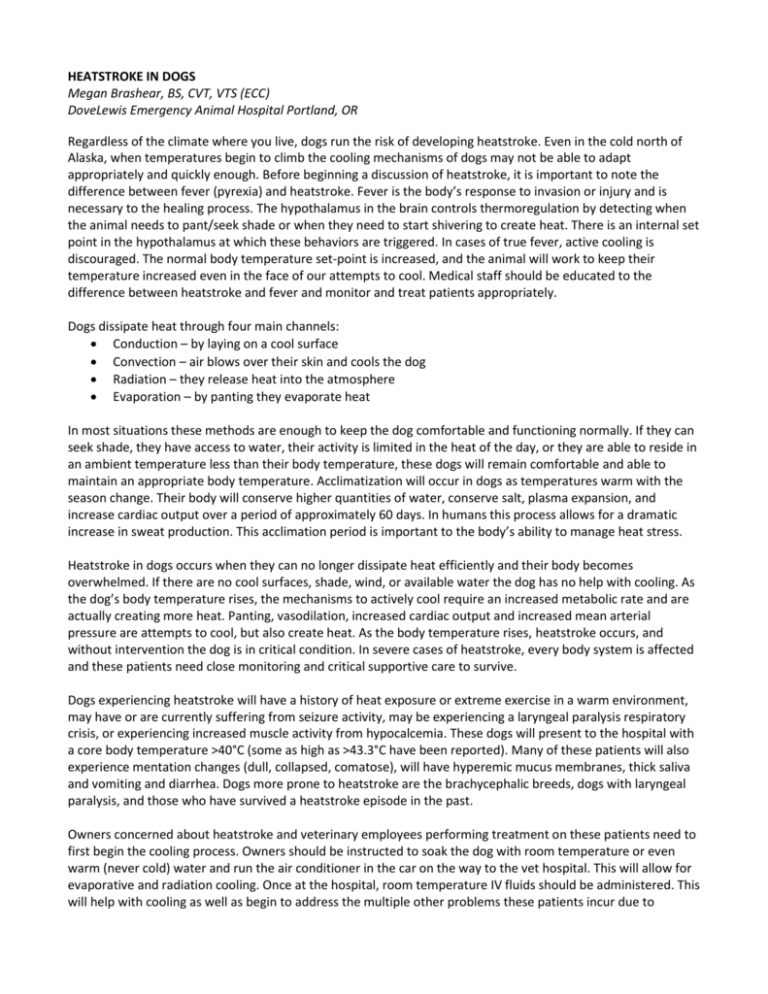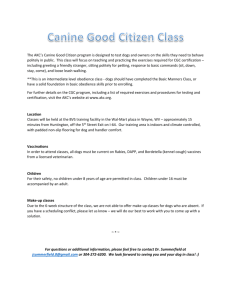Heatstroke in Dogs
advertisement

HEATSTROKE IN DOGS Megan Brashear, BS, CVT, VTS (ECC) DoveLewis Emergency Animal Hospital Portland, OR Regardless of the climate where you live, dogs run the risk of developing heatstroke. Even in the cold north of Alaska, when temperatures begin to climb the cooling mechanisms of dogs may not be able to adapt appropriately and quickly enough. Before beginning a discussion of heatstroke, it is important to note the difference between fever (pyrexia) and heatstroke. Fever is the body’s response to invasion or injury and is necessary to the healing process. The hypothalamus in the brain controls thermoregulation by detecting when the animal needs to pant/seek shade or when they need to start shivering to create heat. There is an internal set point in the hypothalamus at which these behaviors are triggered. In cases of true fever, active cooling is discouraged. The normal body temperature set-point is increased, and the animal will work to keep their temperature increased even in the face of our attempts to cool. Medical staff should be educated to the difference between heatstroke and fever and monitor and treat patients appropriately. Dogs dissipate heat through four main channels: Conduction – by laying on a cool surface Convection – air blows over their skin and cools the dog Radiation – they release heat into the atmosphere Evaporation – by panting they evaporate heat In most situations these methods are enough to keep the dog comfortable and functioning normally. If they can seek shade, they have access to water, their activity is limited in the heat of the day, or they are able to reside in an ambient temperature less than their body temperature, these dogs will remain comfortable and able to maintain an appropriate body temperature. Acclimatization will occur in dogs as temperatures warm with the season change. Their body will conserve higher quantities of water, conserve salt, plasma expansion, and increase cardiac output over a period of approximately 60 days. In humans this process allows for a dramatic increase in sweat production. This acclimation period is important to the body’s ability to manage heat stress. Heatstroke in dogs occurs when they can no longer dissipate heat efficiently and their body becomes overwhelmed. If there are no cool surfaces, shade, wind, or available water the dog has no help with cooling. As the dog’s body temperature rises, the mechanisms to actively cool require an increased metabolic rate and are actually creating more heat. Panting, vasodilation, increased cardiac output and increased mean arterial pressure are attempts to cool, but also create heat. As the body temperature rises, heatstroke occurs, and without intervention the dog is in critical condition. In severe cases of heatstroke, every body system is affected and these patients need close monitoring and critical supportive care to survive. Dogs experiencing heatstroke will have a history of heat exposure or extreme exercise in a warm environment, may have or are currently suffering from seizure activity, may be experiencing a laryngeal paralysis respiratory crisis, or experiencing increased muscle activity from hypocalcemia. These dogs will present to the hospital with a core body temperature >40°C (some as high as >43.3°C have been reported). Many of these patients will also experience mentation changes (dull, collapsed, comatose), will have hyperemic mucus membranes, thick saliva and vomiting and diarrhea. Dogs more prone to heatstroke are the brachycephalic breeds, dogs with laryngeal paralysis, and those who have survived a heatstroke episode in the past. Owners concerned about heatstroke and veterinary employees performing treatment on these patients need to first begin the cooling process. Owners should be instructed to soak the dog with room temperature or even warm (never cold) water and run the air conditioner in the car on the way to the vet hospital. This will allow for evaporative and radiation cooling. Once at the hospital, room temperature IV fluids should be administered. This will help with cooling as well as begin to address the multiple other problems these patients incur due to thermal injury. Core temperatures above 41ºC can lead to permanent brain damage; above 43ºC leads to organ damage. Cool water enemas and cool water gastric lavage can also be methods of cooling heatstroke patients, but be aware that after an enema, rectal temperature readings will no longer be accurate. The issue of using alcohol on the pads of heatstroke patients is often mentioned – but it is no longer a recommended treatment. Not only is the surface area of the paw pads so small, the vasodilation occurring in these patients can lead to increased absorption of alcohol into the bloodstream. It is important to stop active cooling once the dog’s temperature reaches 39.4ºC, dry the patient and closely monitor their temperature and start warming methods as needed. Because all body systems are affected by thermal injury, the cooling process is only the beginning of treatment. A complete physical exam must be performed early and the patient monitored closely for decline or change. Baseline blood work including a CBC and full serum chemistry panel are performed to assess organ function. The patient should be monitored for coagulation function and observed closely for changes in perfusion, mentation, comfort, and infection. NUEROLOGIC SYSTEM: The intense heat experienced by heatstroke patients can cause cell rupture, at core temperatures of 49-50°C cellular necrosis occurs. Cellular death leads to edema and cerebral edema manifests as mentation changes in the patient. Heatstroke patients often present collapsed, but they can be stumbling/ataxic, mentally inappropriate, or even present to the hospital with seizure activity. Reasons for mentation changes can range from poor cerebral perfusion, cerebral edema, direct thermal damage or hemorrhage. Decreased blood glucose levels can lead to seizure activity and should be checked to rule out hypoglycemia. Appropriate treatment with mannitol (0.5 – 1 gram/kg slow IV) should be considered if the dog’s mentation fails to improve with treatment. Dogs that suffer from heatstroke should have their mentation evaluated often and close attention paid to declining changes. SHOCK: During thermal injury the body peripherally vasodilates, essentially decentralizing blood flow to bring as much to the surface in an attempt to cool, and heatstroke patients can quickly experience hypovolemic shock. Evaporative cooling concurrently (panting) can dehydrate the dog. Early in the process, cardiac output must increase to maintain blood pressure, but the dog cannot sustain this long term. As the heat situation becomes more dire cardiac output decreases and blood pressure and perfusion decrease as well. In other cases of hypovolemic shock the dog will vasoconstrict in an attempt to keep major organs perfused, but heatstroke patients remain vasodilated as they continue to attempt to dissipate heat. Every major organ system fails to receive appropriate blood flow and can suffer ischemic injury. As a result we will see the clinical signs of shock in these heatstroke patients. Tachycardia, poor pulses, hyperemic mucus membranes and brisk CRT (some may have progressed to pale mucus membranes), and poor perfusion signal shock. Fluid therapy remains the mainstay of treatment for shock. Crystalloids are administered to clinical endpoints (decreasing tachycardia and increasing blood pressure) with the nursing team providing continued monitoring for patient improvement. Colloids may be used concurrently with crystalloids to maintain appropriate blood pressure and oncotic pressure. Hospitals with access to blood products may consider plasma and albumin products for lifethreatening cases. GI SYSTEM and SEPSIS: A combination of direct thermal injury to tissues and poor perfusion to the gut can cause GI ulceration and often vomiting and diarrhea. In many cases, evidence of intestinal sloughing is seen in the diarrhea. Breakdown of the gut mucosal barrier can quickly lead to gut-derived sepsis. Broad spectrum antibiotics should be considered in patients that present with heatstroke and hematochezia/hematemisis to treat the onslaught of bacteria. Blood glucose levels should be monitored frequently and hypoglycemia addressed as needed. With sepsis often comes hypotension and blood pressure must be closely monitored. SIRS The increase in body temperature experienced in heatstroke triggers both a pro-inflammatory and antiinflammatory response in the body. This response can increase gut permeability but also puts the patient at risk for developing SIRS (Systemic Inflammatory Response Syndrome) as the body’s systemic response to an inflammatory focus. SIRS and sepsis often go hand in hand, and in heatstroke patients can be seen concurrently. Dogs with an inflammatory insult are at risk for developing SIRS if they have two or more of the following parameters: Tachycardia (>120bpm) Tachypnea (>20bpm) Temperature (>103.5°F <100°F) CBC (Neutrophils >18k <5k or >10% band cells) SIRS leads to a loss of vascular tone creating blood pressure challenges and poor organ perfusion, disturbance of the endothelial permeability barrier and can stimulate inappropriate coagulation. Cytokine release can lead to coagulation in the microvasculature and contribute to organ failure. In severe heatstroke, SIRS and sepsis can overwhelm a dog very quickly and the medical team needs to be aware of this and monitor blood glucose levels, supplement with IV dextrose as needed, provide antibiotics, and monitor WBC. Barrier nursing must be implemented in these patients to prevent secondary infections, and care taken with bedding and medical equipment used. COAGULOPATHY: Coagulopathy is common in heatstroke patients. As mentioned previously, SIRS activates the clotting cascade and clotting factors are consumed. Hemorrhage can occur and can be catastrophic. Direct thermal injury to the endothelium and liver from extreme heat can also lead to inappropriate bleeding and the dog’s inability to appropriately replace clotting factors. Once the clotting factors are consumed it is common to see petechiation, ecchymosis, hematochezia, hematemisis, and bleeding from injection sites. Clotting times should be measured and monitored and the patient treated with plasma and PRBC as needed. Platelet counts should also be performed and monitored as these will often drop as well. HEPATIC SYSTEM: With body temperatures as high as are seen in severe heatstroke cases, the liver often suffers direct thermal damage. These dogs cannot rebound from clotting factor losses due to this damage. Liver enzyme elevations are common and should be monitored. Some patients may become icteric as total bilirubin levels rise due to red blood cell breakdown. In these cases an abdominal ultrasound may be necessary to rule out any surgical reasons for elevated total bilirubin (such as sloughing tissue causing gall bladder obstruction). KIDNEYS: As blood shifts from the dog’s core to the periphery in an attempt to cool, the kidneys can experience a decrease in perfusion. As the dog continues to lose water and experience further and severe hypovolemic shock, the kidneys begin to experience damage and azotemia is noted in lab work. Inappropriate bleeding from lost clotting factors can also cause bleeding into the kidneys. Urine output is important to monitor in these patients, and measures taken to ensure that they are able to process the fluids they are receiving. CARDIAC SYSTEM: There are a variety of problems that can result in cardiac arrhythmias, and many heatstroke patients experience most or all of these triggers and are therefore at risk for arrhythmias (mainly ventricular). Hypovolemia, hypoxia, direct thermal injury, ischemia, and reperfusion injury are common. ECG monitoring should be a part of heatstroke patient management and arrhythmias treated as they are noticed. Lidocaine, procainamide, oxygen therapy, pain management, and monitoring electrolytes can be considered when evaluating and treating any cardiac arrhythmias. NUTRITION: Because the GI tract takes such a hit in severe thermal injury, nutrition can be a challenge in these patients. Protein levels can quickly drop and be tough to combat even in the face of multiple plasma transfusions. Feeding the gut is an important part of the healing process and should be started early in the treatment process. If possible, trickle feeding through an NG/NE tube should be instituted as soon as the patient is not vomiting. IV nutrition should be considered if enteral nutrition is not tolerated. PAIN: Pain management should not be neglected in the heatstroke patient. If the gut is sloughing these patients will be painful, and even if we cannot see a source of pain, if they are bleeding into organ capsules that is also painful. These patients should be treated with opioids as needed to keep them comfortable during their hospital stay. Heatstroke is a syndrome that requires quick and knowledgeable action from both the owner and the veterinary team. Multiple organ systems can be affected and need close monitoring. Nursing care is extensive and requires knowledge of what can occur, and heads up communication between teams is necessary. With excellent nursing care and supportive care it is possible for these patients to recover and return to normal lives. Suggested Reading: Creedon, Jamie M. Burkitt., and Harold Davis. Advanced Monitoring and Procedures for Small Animal Emergency and Critical Care. Chichester, West Sussex: Wiley-Blackwell, 2012. Print. Johnson, Scott I., Maureen McMichael, and George White. "Heatstroke in Small Animal Medicine: A Clinical Practice Review." Journal of Veterinary Emergency and Critical Care 16.2 (2006): 112-19. Web. Silverstein, Deborah C., and Kate Hopper. Small Animal Critical Care Medicine. St. Louis, MO: Saunders/Elsevier, 2009. Print. Wingfield, Wayne E., and Marc R. Raffe. The Veterinary ICU Book. Jackson Hole, WY: Teton NewMedia, 2002. Print.




